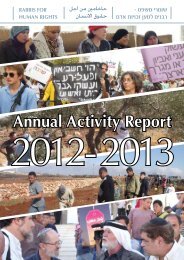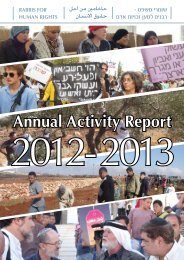2012- 2013
You also want an ePaper? Increase the reach of your titles
YUMPU automatically turns print PDFs into web optimized ePapers that Google loves.
Portrait of one of our young rabbis/rabbinical students:<br />
Nico Sokolovsky<br />
For the past two years, Nico Sokolovsky managed our Rights Center in Hadera. In June <strong>2012</strong> he left in order<br />
to complete his rabbinical studies in the US. Nico offers the following thoughts on the center and on his<br />
experience in the field:<br />
“The center in Hadera is our opportunity to be present in the place where we are needed – it is no coincidence<br />
that Makom [place, in Hebrew] is one of the names of God. The center is an expression of our support for<br />
a population that does not get a hearing owing to its position and location… Indeed in this place we get an<br />
opportunity to be present! “Being present,” after two years in this position, is in my understanding a mitzvah of<br />
the highest importance – maybe it should be included in the Ten Commandments. “I am the Lord your God” is<br />
interpreted by the Rambam as a command to know God; I interpret it as an invitation to be present.<br />
My job gave me the chance to visit and to accompany the sick; to care for the poor, the widow, the orphan,<br />
the weak, and those beaten by the system; and to try to improve on the experiment of realizing the dream of<br />
a Jewish state; to feel that I am engaged in the Jewish-Zionist enterprise; to raise my voice and shout against<br />
the loss of direction that our country suffers from…To leave (if only for a minute) the small closed reality that I<br />
live in and to meet the “other” (in terms of economic status, social grouping, religion, etc.) and – through this<br />
meeting with him or her – to widen my knowledge of my God. As a result of my work for this organization,<br />
my understanding of justice has deepened. Thank you!”<br />
Special Projects<br />
Under the direction of Rabbi Arik Ascherman, RHR has developed a number of special projects. These<br />
projects include our work with public housing tenants to ameliorate public housing; to support the African<br />
asylum seekers; and to advocate for the struggle of the unrecognized Bedouin villages in the Negev.<br />
Public Housing<br />
The initiatives described in last<br />
year’s report have blossomed into<br />
a major program area for RHR.<br />
While affordable housing was<br />
one of the main rallying cries of<br />
the 2011 protest movement, most<br />
of the demands have since been<br />
“buried” in committees. The need<br />
is great. Over 40,000 Israelis are<br />
on the official waiting list for public<br />
housing, many waiting for six years<br />
or more. However, the list does not<br />
reflect the actual need. Inappropriate<br />
criteria leave many like the late<br />
Moshe Silman ineligible for support.<br />
Many of those in need repeatedly<br />
rent apartments they cannot afford<br />
until they are evicted, while others<br />
sleep in cars, on friends’ sofas or on<br />
park benches. The trauma suffered<br />
by children is particularly tragic.<br />
Nothing is done to replenish the<br />
public housing stock, let alone to<br />
increase it. Many existing apartments<br />
are in need of serious repair and<br />
some suffer from potentially lifethreatening<br />
problems. Thousands of<br />
other government owned buildings<br />
are left empty. Money intended<br />
for public housing is diverted to<br />
other uses, while those in need<br />
face an often obtuse and insensitive<br />
bureaucracy.<br />
Last year we described how we<br />
first encountered this issue in Beit<br />
Shean and began to develop our<br />
policy recommendations together<br />
with public housing residents<br />
in the city. At the time, the local<br />
branch of Amidar, one of Israel’s<br />
semi-governmental public housing<br />
companies, seemed utterly<br />
unresponsive and sometimes even<br />
hostile. With the guidance of Rabbi<br />
Arik Ascherman, Rabbi Kobi Weiss<br />
has reversed this situation. Realizing<br />
that the root of the problems in<br />
Beit Shean is the difficulty<br />
that individuals face when<br />
standing alone against a<br />
powerful bureaucracy, Rabbi Weiss<br />
opened lines of communication<br />
with Amidar. Students from RHR’s<br />
Jezreel Valley College Human<br />
Rights Yeshiva, and area volunteers,<br />
including some who live in public<br />
housing, he has helped resolve<br />
debts, avoid eviction, obtain repairs,<br />
find appropriate apartments, etc.<br />
This past June, Jezreel Valley College<br />
chose the work of human services<br />
student Rivka Yones with RHR’s<br />
public housing advocacy program<br />
in Beit Shean as one of the two<br />
outstanding projects of the year, out<br />
of 130 competing projects. Since<br />
September of 2011, we have helped<br />
85 tenants, successfully resolving 25<br />
cases and assisting in the resolution<br />
of an additional 20 cases. We are<br />
continuing to work on most of the<br />
open cases. Our challenge is that most<br />
of the tenants with open cases have<br />
problems related to policies decided<br />
at the regional or national level;<br />
we are drawing on the issues these<br />
cases raise as we move forward with<br />
efforts to change national policy (see<br />
below). It is not our goal to remain in<br />
Beit Shean indefinitely: this year we<br />
are focusing on empowering tenants<br />
and local volunteers to support each<br />
other and to resolve problems on<br />
their own.<br />
While in Beit Shean we work mainly<br />
with public housing tenants, RHR<br />
works in Jerusalem with those who are<br />
not even deemed eligible for public<br />
housing due to unrealistic criteria.<br />
The protest encampment initially<br />
sponsored and sustained by RHR<br />
in 2011 has become a collective of<br />
activists and those in need of public<br />
housing called “the Ma’abarah”<br />
(echoing the name given to transit<br />
camps for new immigrants to Israel<br />
in the 1950’s). Long after the middle<br />
class protestors folded up their tents<br />
in the fall of 2011, the Ma’abarah<br />
was one of a handful of low income<br />
groups that continued the struggle.<br />
With many members literally having<br />
nowhere to live, the collective<br />
broke into abandoned buildings (an<br />
activity not sanctioned by RHR), set<br />
up new encampment sites or lived<br />
in donated office space, until the<br />
Municipality eventually provided<br />
supplementary funds allowing those<br />
in need to rent. However, these<br />
funds have now run out, and some<br />
members of the Ma’abarah are again<br />
in danger of eviction.<br />
The Ma’abarah has been one of<br />
the groups continuing with high<br />
profile protests highlighting the<br />
unresponsiveness of municipal<br />
and national officials. For example,<br />
during the Sukkot holiday the<br />
Ma’abarah built a “Sukkah on<br />
Wheels” representing needed<br />
homes, and paraded from Jerusalem<br />
Mayor Nir Barkat’s public Sukkah<br />
to the home of Prime Minister<br />
Netanyahu to a large public gathering<br />
of Kurdish Jewry in Sacher Park.<br />
These protests elicited a defensive<br />
reaction from outgoing Housing<br />
Minister Ariel Atias. While he didn’t<br />
change the problematic way his<br />
Ministry operated, Atias made some<br />
proposals to replenish the supply<br />
of public housing. The proposals<br />
constituted an insufficient step in<br />
the right direction, but they were<br />
not adopted by the government. In<br />
some cases demonstrations were<br />
met with police brutality and arrests.<br />
The Ma’abarah has waged several<br />
campaigns on behalf of individuals<br />
faced with eviction, most notably<br />
waging a successful campaign<br />
against Amidar to prevent the<br />
eviction of Ovadia and Miriam Ben<br />
Avraham. In a very powerful Tisha<br />
B’Av Mincha service and program,<br />
RHR and the Ma’abarah drew links<br />
between the loss of our national<br />
home mourned on Tisha B’Av and<br />
the housing insecurity facing many<br />
Israelis. We also built on the theme of<br />
emerging hope which characterizes<br />
the Tisha B’Av Mincha.<br />
In May <strong>2012</strong>, the Ma’abarah entered<br />
a former kindergarten abandoned<br />
for three years in the low income<br />
Katamonim neighborhood, where<br />
the need for public housing<br />
is particularly acute. It<br />
turned out that this property<br />
<br />
RHR <strong>2013</strong> 20<br />
21 RHR <strong>2013</strong>









